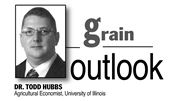|
Too Early To Worry About Corn Acreage?

Recent unseasonably cold and wet weather over much of the Corn Belt precipitates speculation into the prospect of reduced corn acreage this year. With March Prospective Plantings at 88 million acres, a reduction in corn acreage under the recent strong demand levels for corn creates a supportive scenario for corn prices moving forward.
Despite larger than expected March 1 corn stocks, the strong demand for corn exports and ethanol production continues to provide backing to corn prices as we move into the planting season. The December 2018 corn futures price contract increased sharply following the release of the prospective plantings report and settled into a marketing year high until the recent uptick of volatility associated with trade issues. New crop futures moved lower over the past week despite the start to planting season in the Corn Belt showing potential for significant delays. April is shaping up to be one of the coldest in the last 120 years in the Corn Belt and northern Plains. Through April 7, over 75 percent of the prospective planted corn acres contains soil too cold and wet to start planting. The prospect of planting delays raises questions about the likely magnitude of final corn acreage and the possible impact on yields.
Some indication of the potential acreage impact of continued delays in planting is revealed by the acreage response in years of late planting. While no set definition of late planting exists for corn, the previous analysis used here defined late planting occurring after May 20 for a majority of corn production areas. Additionally, a threshold of greater than 20 percent is assumed for a large amount of late planting. Using these definitions and weekly planting progress reports, a calculation of the percentage of the crop planted late each year is possible. Since 1997, there have been seven years when the USDA's weekly Crop Progress report indicated that 20 percent or more of the corn crop was planted after May 20. The final USDA estimate of planted acreage was less than March intentions reported during six of those years. Late planting ranged from 20 to 29 percent in those years and acreage came in lower than intentions by an average of 643,000 acres, ranging from 32,000 (2008) to 1,917,000 (2013) acres. The only exception occurred during 2009 when 29 percent of the crop was planted late; final acreage exceeded intentions by 1.396 million acres. During those same years, the acreage response shown in the June acreage report presented a different picture. June intentions acreage came in higher than March intentions by an average of 218,000 acres, ranging from -200,000 (2002) to 2,049,000 (2009) acres. June intentions came in on average 831,000 acres larger than final acreage in late planting years.
Research related to late planting and corn yield potential indicates a yield loss associated with late planting, particularly when planting dates get pushed past the third week of May. In the seven years since 1997 with the largest percentage of the crop planted late, the U.S. average yield was below trend in two years. Corn yield came in near trend in three years and above trend in two years over the period. Considerable variation in national corn yield relative to trend is present despite the amount of the crop planted at a later date. Substantial yield adjustments hinge on the weather during the growing season rather than planting date. If a large portion of corn planting gets pushed back into late May, the potential for decreased yield comes into play.
The previous two decades of corn acreage adjustments show the potential for declines from March planting intentions associated with late planting. Acreage adjustments varied widely during the period, and no definitive result is predictable at the national aggregate level. For this year, concerns around corn planting delays focus on the northern Plains and upper Midwest where continued snow accumulation and cold soil temperatures suggest a potential for persistent delays. These areas possess a smaller planting window for prime corn yields. A shift away from corn acreage in those areas is feasible as acreage is moved into different crops or goes unplanted. The impact on spring wheat and soybean acreage may be even more pronounced in many areas of the Corn Belt if planting is significantly delayed. Overall, less corn acreage than reported in March seems likely if planting delays continue.
The potential size of the 2018 U.S. corn crop is uncertain at this early stage of the planting season. A continuation of cold and wet weather over large portions of the Corn Belt could lead to losses in corn acreage. It is too early to write off corn acreage at this point since time remains to plant the crop, but continued delays narrow the window for planting without the prospect of yield losses. The next three weeks of planting progress reports should bring the potential for corn acreage adjustments into stronger focus. Expectations about corn acreage will gain a more accurate assessment in the USDA’s June 29 Acreage report. ∆
DR. TODD HUBBS: Agricultural Economist, University of Illinois
|
|